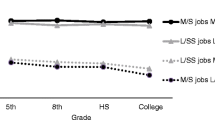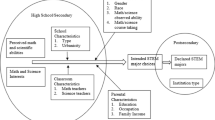Abstract
Career aspirations in science, technology, engineering, and mathematics (STEM) are formulated in adolescence, making the high school years a critical time period for identifying the cognitive and motivational factors that increase the likelihood of future STEM employment. While past research has mainly focused on absolute cognitive ability levels in math and verbal domains, the current study tested whether relative cognitive strengths and interests in math, science, and verbal domains in high school were more accurate predictors of STEM career decisions. Data were drawn from a national longitudinal study in the United States (N = 1762; 48 % female; the first wave during ninth grade and the last wave at age 33). Results revealed that in the high-verbal/high-math/high-science ability group, individuals with higher science task values and lower orientation toward altruism were more likely to select STEM occupations. In the low-verbal/moderate-math/moderate-science ability group, individuals with higher math ability and higher math task values were more likely to select STEM occupations. The findings suggest that youth with asymmetrical cognitive ability profiles are more likely to select careers that utilize their cognitive strengths rather than their weaknesses, while symmetrical cognitive ability profiles may grant youth more flexibility in their options, allowing their interests and values to guide their career decisions.
Similar content being viewed by others
References
Allison, P. D. (2012). Handling missing data by maximum likelihood. Paper presented at the SAS Global Forum, Orlando, Florida.
Asparouhov, T. (2006). General multilevel modeling with sampling weights. Communications in Statistics: Theory and Methods, 35, 439–460.
Atkinson, R. D., Hugo, J., Lundgren, D., Shapiro, M. J., & Thomas, J. (2007). Addressing the STEM challenge by expanding specialty math and science high schools. NCSSSMST Journal http://files.eric.ed.gov/fulltext/EJ855272.pdf.
Bergman, L. R. (2001). A person approach in research on adolescence: Some methodological challenges. In A. von Eye & C. Schuster. Journal of Adolescent Research, 16(Special Issue), 28–53.
Bleeker, M., & Jacobs, J. E. (2004). Achievement in math and science: Do mothers’ beliefs matter 12 years later?. Journal of Educational Psychology, 96, 97–109.
Ceci, S. J., & Williams, W. M. (2010). Sex differences in math-intensive fields. Current Directions in Psychological Science, 19, 275–279.
Cheryan, S., & Plaut, V. C. (2010). Explaining underrepresentation: A theory of precluded interest. Sex Roles, 63, 475–488. doi:10.1007/s11199-010-9835-x.
Chow, A., Eccles, J. S., & Salmela-Aro, K. (2012). Task value profiles across subjects and aspirations to physical and IT-related sciences in the United States and Finland. Developmental Psychology, 48, 1612–1628.
Diekman, A. B., Brown, E. R., Johnston, A. M., & Clark, E. K. (2010). Seeking congruity between goals and roles: A new look at why women opt out of science, technology, engineering, and mathematics careers. Psychological Science, 21, 1051–1057.
Diekman, A. B., Clark, E. K., Johnston, A. M., Brown, E. R., & Steinberg, M. (2011). Malleability in communal goals and beliefs influences attraction to STEM careers: Evidence for a goal congruity perspective. Journal of Personality and Social Psychology, 101, 902–918.
Eccles, J. S. (2009). Who am I and what am I going to do with my life? Personal and collective identities as motivators of action. Educational Psychologist, 44, 78–89.
Eccles, J. S., Lord, S. E., Roeser, R. W., Barber, B. L., & Jozefowicz, D. M. (1997). The association of school transitions in early adolescence with developmental trajectories through high school. In J. Schulenberg, J. I. Maggs, & K. Hurrelmann (Eds.), Health risks and developmental transitions during adolescence (pp. 283–321). New York: Cambridge University Press.
Eccles, J. S., Wigfield, A., & Schiefele, U. (1998). Motivation. In N. Eisenberg (Ed.), Handbook of child psychology, Vol. 3. 5th edn. (pp. 1017–1095). New York: Wiley.
Else-Quest, N. M., Mineo, C. C., & Higgins, A. (2013). Math and science attitudes and achievement at the intersection of gender and ethnicity. Psychology of Women Quarterly, 37, 293–309.
Gregory, A., & Weinstein, R. S. (2004). Connection and regulation at home and in school: Predicting growth in achievement for adolescents. Journal of Adolescent Research, 19, 405–427.
Hayenga, A. O., & Corpus, J. H. (2010). Profiles of intrinsic and extrinsic motivations: A person-centered approach to motivation and achievement in middle school. Motivation and Emotion, 34, 371–383.
Kell, H. J., Lubinski, D., Benbow, C. P., & Steiger, J. H. (2013). Creativity and technical innovation: Spatial ability’s unique role. Psychological Science, 24, 1831–1836.
Kelly, S. (2009). The Black–White gap in mathematics course taking. Sociology of Education, 82, 47–69.
Landivar, L. C. (2013). Disparities in STEM employment by sex, race, and Hispanic origin. American Community Survey Reports, ACS-24. Washington, D.C: U.S. Census Bureau.
Li, M., Shavelson, R. J., Kupermintz, H., & Ruiz-Primo, M. A. (2002). On the relationship between mathematics and science achievement in the United States. In D. F. Robitaille, & A. E. Beaton (Eds.), Secondary analysis of the TIMSS data (pp. 233–249). Netherlands: Springer.
Ma, X., & Wilkins, J. L. (2002). The development of science achievement in middle and high school: Individual differences and school effects. Evaluation Review, 26, 395–417.
Malone, K. R., & Barabino, G. (2009). Narrations of race in STEM research settings: Identity formation and its discontents. Science Education, 93, 485–510.
Maltese, A. V., & Tai, R. H. (2011). Pipeline persistence: Examining the association of educational experiences with earned degrees in STEM among U.S. students. Science Education, 95, 877–907.
Mason, M. A., & Goulden, M. (2004). Marriage and baby blues: Redefining gender equity and the academy. Annals of the American Political and Social Sciences, 596, 86–103. doi:10.1177/000271620459600104.
Miller, J. D. Longitudinal Study of American Youth, 1987-1994, and 2007 [Computer file]. ICPSR30263-v1. Ann Arbor, MI: Inter-university Consortium for Political and Social Research [distributor], 2011-04-01. doi:10.3886/ICPSR30263.v1.
Miller, J. D., & Kimmel, L. G. (2012). Pathways to a STEMM profession. Peabody Journal of Education, 87, 26–45.
Miller, J. D., & Solberg, V. S. (2012). The composition of the STEMM workforce: Rationale for differentiating STEMM professional and STEMM support careers. Peabody Journal of Education, 87, 6–15
National Assessment of Educational Progress. (1986a). Math Objectives 1985-86 Assessment. Princeton, NJ: Educational Testing Service.
National Assessment of Educational Progress. (1986b). Science Objectives 1985-86 Assessment. Princeton, NJ: Educational Testing Service.
Park, G., Lubinski, D., & Benbow, C. P. (2007). Contrasting intellectual patterns predict creativity in the arts and sciences: Tracking intellectually precocious youth over 25 years. Psychological Science, 18, 948–952.
Parker, P., Nagy, G., Trautwein, U., & Ludtke, O. (2014). Predicting career aspirations and university majors from academic ability and self-concept: A longitudinal application of the internal–external frame of reference model. In I. Schoon, & J. S. Eccles (Eds.), Gender differences in aspirations and attainment: A life course perspective (pp. 224–246). Cambridge, UK: Cambridge University Press.
Ramaswamy, V., DeSarbo, W., Reibstein, D., & Robinson, W. (1993). An empirical pooling approach for estimating marketing mix elasticities with PIMS data. Marketing Science, 12, 103–124.
Riegle-Crumb, C., King, B., Grodsky, E., & Muller, C. (2012). The more things change, the more they stay the same? Prior achievement fails to explain gender inequality in entry into STEM college majors over time. American Educational Research Journal, 49, 1048–1073.
Schwartz, G. (1978). Estimating the dimensions of a model. The Annals of Statistics, 6, 461–464.
Sikora, J., & Pokropek, A. (2012). Gender segregation of adolescent science career plans in 50 countries. Science Education, 96, 234–264.
Simpkins, S. D., Fredricks, J. A., & Eccles, J. S. (2012). Charting the Eccles’ expectancy-value model from mothers’ beliefs in childhood to youths’ activities in adolescence. Developmental Psychology, 48, 1019–1032.
Wang, M. T. (2012). Educational and career interests in math: A longitudinal examination of the links between classroom environment, motivational beliefs, and interests. Developmental Psychology, 1, 1–22.
Wang, M. -T., & Degol, J. L. (2016). Gender gap in science, technology, engineering, and mathematics (STEM): Current knowledge, implications for practice, policy, and future directions. Educational Psychology Review, 28, 1–22.
Wang, M. -T., & Degol, J. L. (2013). Motivational pathways to STEM career choices: Using expectancy-value perspective to understand individual and gender differences in STEM fields. Developmental Review, 33, 304–340.
Wang, M. -T., Degol, J. L., & Ye, F. (2015). Math achievement is important, but task values are critical too: Examining the intellectual and motivational factors leading to gender disparities in STEM careers. Frontiers in Psychology, 6, 1–9.
Wang, M. T., Eccles, J. S., & Kenny, S. (2013). Not lack of ability but more choice: Individual and gender differences in STEM career choice. Psychological Science, 24, 770–775.
Wigfield, A., Byrnes, J. P., & Eccles, J. S. (2006). Development during early and middle adolescence. In P. A. Alexander, & P. H. Winne (Eds.), Handbook of educational psychology, 2nd edition (pp. 87–114). New York: Taylor & Francis.
Williams, W. M., & Ceci, S. J. (2012). When scientists choose motherhood: A single factor goes a long way in explaining the dearth of women in math-intensive fields. How can we address it? American Scientist, 100, 138–145. doi:10.1511/2012.95.138.
U.S. Department of Education, National Center for Education Statistics. (2015). The condition of education: Concentration of public school students eligible for free or reduced-price lunch. Retrieved on February 24, 2016 from http://nces.ed.gov/programs/coe/indicator_clb.asp.
Valla, J. M., & Ceci, S. J. (2014). Breadth-based models of women’s underrepresentation in STEM fields: An integrative commentary on Schmidt (2011) and Nye et al. (2012). Perspectives on Psychological Science, 9, 219–224.
Funding
This project was supported by Grant HD074731-01 from the Eunice Kennedy Shriver National Institute of Child Health and Development (NICHD).
Authors’ Contributions
MTW conceived of the study, participated in its design and coordination and drafted the manuscript; FY participated in the design and interpretation of the data and performed the statistical analysis; JLD participated in the interpretation of the data and drafted part of the manuscript. The second and third authors made equal intellectual contribution to the manuscript. All authors read and approved the final manuscript.
Author information
Authors and Affiliations
Corresponding author
Ethics declarations
Conflicts of Interest
The authors declare that they have no conflict of interest.
Ethical Approval
All procedures performed in studies involving human participants were in accordance with the ethical standards of the institutional and/or national research committee and with the 1964 Helsinki declaration and its later amendments or comparable ethical standards. A review conducted by the Institutional Review Board approved the study to be consistent with the protection of the rights and welfare of human subjects and to meet the requirements of the Federal Guidelines.
Informed Consent
Informed consent was obtained from all individual participants included in the study.
Additional information
Jessica Lauren Degol and Feifei Ye made equal intellectual contribution to the manuscript.
Rights and permissions
About this article
Cite this article
Wang, MT., Ye, F. & Degol, J.L. Who Chooses STEM Careers? Using A Relative Cognitive Strength and Interest Model to Predict Careers in Science, Technology, Engineering, and Mathematics. J Youth Adolescence 46, 1805–1820 (2017). https://doi.org/10.1007/s10964-016-0618-8
Received:
Accepted:
Published:
Issue Date:
DOI: https://doi.org/10.1007/s10964-016-0618-8




